2021c:
Xenophon’s Cyaxares: Uncle of Cyrus, Friend of Daniel
JETS 64.2 (June 2021): 265-85.
Download PDF
Download HTML |
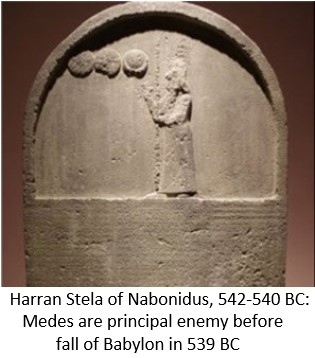 The capture of Babylon by a coalition of forces under the leadership of Cyrus the Great is written about, as a prophecy, in the biblical books of Isaiah and Jeremiah. In these books,
priority in the conquest is not given to Persia, as might be expected, but to Media. This is also consistent with the Book of Daniel, in which the handwriting on the wall at Belshazzar’s feast mentions the Medes before the Persians. Also in the Book of Daniel, a Mede is named as receiving the kingdom after the slaying of Belshazzar.
The capture of Babylon by a coalition of forces under the leadership of Cyrus the Great is written about, as a prophecy, in the biblical books of Isaiah and Jeremiah. In these books,
priority in the conquest is not given to Persia, as might be expected, but to Media. This is also consistent with the Book of Daniel, in which the handwriting on the wall at Belshazzar’s feast mentions the Medes before the Persians. Also in the Book of Daniel, a Mede is named as receiving the kingdom after the slaying of Belshazzar.
This emphasis on the Medes over the Persians in the Bible is consistent with the Harran Stela, commissioned by Babylon’s king Nabonidus just three years or less before the fall of Babylon in 539 BC. The Stela names the Medes as a principal enemy, without mentioning the Persians because Nabonidus considered them as under the suzerainty of the Medes at the time.
The present article examines these issues, focusing on how they relate to the existence or non-existence of the Median king at the time, Cyaxares II. This Cyaxares is presented as a major actor in the history of the time in Xenophon’s Cyropaedia, but the consensus of modern historians is that he is entirely fictitious, the invention of Xenophon. The reasoning behind the consensus view is explained, and the reasons favoring the alternative view—that Cyaxares was a real person—are given, along with the insights that the alternative view offers in interpreting some difficult passages in the Book of Daniel.
|
| 2021b:
Interview with Dr. Andreas Köstenberger on the importance of studying Biblical chronology |
|
In December 2019 Andreas Köstenberger interviewed Andrew Steinmann and myself on the subject of Biblical chronology. Dr. Köstenberger is Research Professor of New Testament and Biblical Theology and Director of the Center for Biblical Studies at Midwestern Baptist Theological Seminary in Kansas City Missouri. At the time he was also chief editor of the Journal of the Evangelical Theological Society. The interview was published in April of 2021 as two podcasts as part of Dr. Köstenberger's "Biblical Foundations" Web site and ministry.
Part 1 (click here to listen) discusses the importance of having the correct Biblical chronology in determining whether the Bible can be trusted to give accurate historical data. An innacurate chronology, one that produces conflict with well-established historical dates, will lead to questions about the reliability and authority of the Bible. On the other hand, if chronological data derived from the Bible can be shown to be systematically accurate with regard to the timing of historical events, the demonstration of such accuracy will support a high view of the inspiration of Scripture.
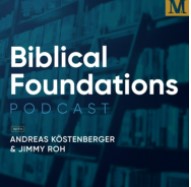 Advocates of the "higher critical" approach to the Bible start with the presupposition that most Biblical texts, particularly those dealing with historical matters, were written after--and frequently long after--the events they describe, with the intent of promoting the theological ideas of the writers. With such a presupposition, it could not be expected that there would be accuracy in the fine details of chronology for events that happened long before they were described by those inventing, or at least loosely interpreting, these events in order to fit their theological agenda.
Advocates of the "higher critical" approach to the Bible start with the presupposition that most Biblical texts, particularly those dealing with historical matters, were written after--and frequently long after--the events they describe, with the intent of promoting the theological ideas of the writers. With such a presupposition, it could not be expected that there would be accuracy in the fine details of chronology for events that happened long before they were described by those inventing, or at least loosely interpreting, these events in order to fit their theological agenda.
In contrast to this approach, the Adventist scholar Edwin Thiele started with the chronological data as found in the relevant books of the Hebrew Bible and sought to determine the dating methods that were used by the ancient court recorders during the Hebrew kingdom period. He used the Scriptural data, along with information from the methods of other Ancient Near Eastern societies, in order to determine these methods. Only after this was done did Thiele construct a chronology for approximately 400 years of the kingdom period. The chronology that resulted was based, therefore, not on his presuppositions, but on the data as given in the historical parts of Scripture. This "inductive" method--one that starts with the data instead of a scholar's presuppositions--is at the core of the scientific method. The success of the inductive approach followed by Thiele and those who built on his work is discussed in the podcast, so that a geologist that Rodger cites (Steven Austin) commented that the accomplishment of Thiele's approach in determining the proper understanding the chronology of this time should be considered as one of the greatest breakthroughs of the Twentieth Century in supporting the authority of the Bible, second in importance only to the discovery of the Dead Sea Scrolls. The success of the method followed by Thiele in producing a complex and coherent chronology for the kingdom period has allowed Assyriologists and Egyptologists to refine their own chronologies based on the Bible's data and chronology.
Part 2 (click here to listen) discusses the importance of having the correct chronology for the reign of Herod the Great. Dr. K asks, What is the basis for the consensus date of Herod's death? Dr. Steinmann replies that it is based on the wrong consular year that Josephus gives for Herod's investiture as king by the Romans. This wrong consular year then leads to a host of other errors in interpreting the chronological data of Josephus. “When we build our chronology of the life of Herod on those consular years we will get multiple conflicts with other statements in Josephus regarding the history of the times.” In the podcast, Dr. Köstenberger says that he is now convinced that, although he once accepted the consensus view that Herod died in 4 BC, he now accepts 1 BC: "You simply have to go with the evidence, and if once you are confronted with the evidence, you continue to hold on to some sort of a conventional explanation, at that point . . . you are no longer, I think, living up to the highest calling of a scholar."
Dr. K then asks about the census in the time of Quirinius and how it relates to the time of our Lord's birth, which gives an occasion for both respondents to present the ideas of John Rhoads as given in his JETS paper "Josephus Misdated the Census of Quirinius." The session closes with a discussion of the importance of a correct chronology in determining that the earliest recorded statements of the divinity of our Lord were made immediately after the Resurrection, as now admitted by even Bart Ehrmann.
|
| 2020c: Seminar and interview at The Bible Seminary, Katy Texas, February 2020 |
Two of my friends who teach at The Bible Seminary in Katy Texas invited me to speak to their graduate archaeology students. The two friends are Dr. Scott Stripling, provost of the seminary, and Dr. Doug Petrovich, professor of Biblical history, exegesis, and Hebrew. The class date was set as February 27, 2020 and the topic was to be the importance of the correct Biblical chronology for archaeological research. It was a great pleasure to meet again with these two colleagues and with Dr. Lynn Lewis, seminary president, and to make new friends among the staff and students. Dr. Lewis also graciously arranged an enjoyable hour and a half of conversation with the eminent NT scholar, Dr. Craig Evans.

On the day following the archaeology class, Drs. Stripling (left) and Petrovich (center) arranged an interview. A caveat about Doug’s over-enthusiastic introduction: my research has been largely confined to the time of the Hebrew kingdom period and going back to the Exodus.
(I also deal extensively with the timing of the Jubilee and Sabbatical cycles.) A scholar who has a broader grasp of all of the Biblical chronology, starting with Abraham and continuing through the NT era, is Dr. Andrew Steinmann. I have had the pleasure of working with Dr. Steinmann for some years now, especially in our current efforts to correct the incoherent consensus (Schürer) chronology for the reign of Herod the Great and the year of birth of our Lord and Savior.
In the recorded interview, I was asked to respond to six questions: (1) How did God guide you into the study of chronology? (2) What is the basis for firmly building an OT chronology? (3) Why does it matter when things happened as long as we believe that they happened? (4) What are the primary weaknesses in the 13th Century BC Exodus theory? (5) What would you say to a scholar who methodologically uses only the Book of Exodus to arrive at his Exodus date? (6) Who are Manetho, Cheremon, and Lysimachus and why do they matter? The podcast of the interview is available by clicking on the image to the right or on the title bar at the top of this section.
|
2020b:
Consular Years and Sabbatical Years in Herod's Life
Bibliotheca Sacra 177 (Oct.-Dec. 2020): 442-61. Co-author: Andrew Steinmann.
Download PDF
Download HTML |
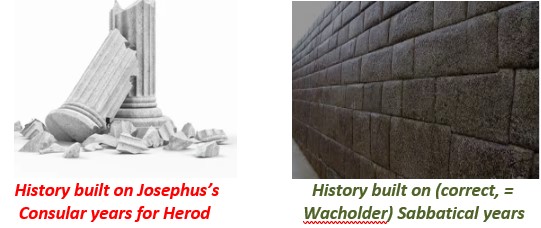 Much of New Testament chronology, especially the dating of Jesus's life, is dependent upon the dates for the reign of Herod the Great. In the late nineteenth century Schürer proposed dates for the reign of Herod: 40 (37) BC to 4 BC. These are suspect and are based on Josephus's erroneous use of Roman consular years. Schürer also cites the sabbatical tables developed by Zuckermann, but this is not an independent source, since they are based on the same citation of consular years in Josephus. When Josephus's error is recognized, the correct dates for Herod's reign are demonstrated to be late 39 BC (made king by Romans), late summer 36 BC (capture of Jerusalem), and early 1 BC (death), placing the birth of Christ in late 3 BC or early 2 BC, a date that is in agreement with virtually every early Christian writers who wrote on the subject.
Much of New Testament chronology, especially the dating of Jesus's life, is dependent upon the dates for the reign of Herod the Great. In the late nineteenth century Schürer proposed dates for the reign of Herod: 40 (37) BC to 4 BC. These are suspect and are based on Josephus's erroneous use of Roman consular years. Schürer also cites the sabbatical tables developed by Zuckermann, but this is not an independent source, since they are based on the same citation of consular years in Josephus. When Josephus's error is recognized, the correct dates for Herod's reign are demonstrated to be late 39 BC (made king by Romans), late summer 36 BC (capture of Jerusalem), and early 1 BC (death), placing the birth of Christ in late 3 BC or early 2 BC, a date that is in agreement with virtually every early Christian writers who wrote on the subject. |
2020a:
Elapsed Times for Herod the Great in Josephus
Bibliothca Sacra July-September 2020 issue. Co-author: Andrew Steinmann.
Download PDF
Download HTML |
 Determining the chronology of Herod the Great, as given in Josephus, involves many questions: consular years, Sabbatical years, Nisan or Tishri years regarding Herod's reign, inclusive or non-inclusive counting for elapsed time, and the year from which Herod's sons considered their reigns to have begun. The present paper focuses on just two of these issues—elapsed time and Nisan versus Tishri years—as dealt with in the two most frequently cited positions formulated for the death of Herod, those of Schürer and Filmer. Tables at the end (see sample at right) demonstrate which of the two views best agrees with the many designations of elapsed time in Josephus.
Determining the chronology of Herod the Great, as given in Josephus, involves many questions: consular years, Sabbatical years, Nisan or Tishri years regarding Herod's reign, inclusive or non-inclusive counting for elapsed time, and the year from which Herod's sons considered their reigns to have begun. The present paper focuses on just two of these issues—elapsed time and Nisan versus Tishri years—as dealt with in the two most frequently cited positions formulated for the death of Herod, those of Schürer and Filmer. Tables at the end (see sample at right) demonstrate which of the two views best agrees with the many designations of elapsed time in Josephus. |
2019c:
Caligula’s Statue for the Jerusalem Temple and Its Relation to the Chronology of Herod the Great
JETS 62:4 (Dec. 2019), 759-73. Co-author: Andrew Steinmann.
Download PDF
Download HTML |
 Abstract: The Emperor Caligula's attempt to put a statue of himself, portrayed as the god Jupiter, in the Holy of Holies of the Jerusalem Temple is described by contemporary authors Josephus and Philo of Alexandria. The chronology of this episode is firmly established by these authors as well as by Roman historians. The challenge of that chronology to the consensus chronology for Herod the Great is described, along with the attempts of consensus scholars to deal with the challenge. Closely related to the Caligula statue issue is a Seder 'Olam passage associating the burning of the Second Temple with a Sabbatical year. New evidence is presented showing that the Seder 'Olam places that event in the latter part of a Sabbatical year, in conflict with the consensus date for a Sabbatical year during Herod the Great’s siege of Jerusalem but in harmony with the minority view that dates the siege to 36 BC.
Abstract: The Emperor Caligula's attempt to put a statue of himself, portrayed as the god Jupiter, in the Holy of Holies of the Jerusalem Temple is described by contemporary authors Josephus and Philo of Alexandria. The chronology of this episode is firmly established by these authors as well as by Roman historians. The challenge of that chronology to the consensus chronology for Herod the Great is described, along with the attempts of consensus scholars to deal with the challenge. Closely related to the Caligula statue issue is a Seder 'Olam passage associating the burning of the Second Temple with a Sabbatical year. New evidence is presented showing that the Seder 'Olam places that event in the latter part of a Sabbatical year, in conflict with the consensus date for a Sabbatical year during Herod the Great’s siege of Jerusalem but in harmony with the minority view that dates the siege to 36 BC.
Key Words: Herod the Great, Schürer, Filmer, Sabbatical years, Jubilees, NT chronology, Josephus, Seder ‘Olam |
2019b:
Presentation on date of death of Herod the Great
Download PDF
Download HTML |
Establishing the year in which Herod the Great died
is necessary in order to determine the date of birth of the Lord Jesus,
which in turn bears on the chronology of the entire New Testament.
In the section that deals with Herod in his first historical work, Wars of the Jews,
Josephus used the Judean method of determining elapsed time, namely
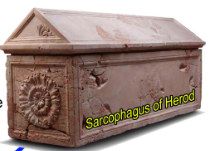 the reign lengths of the high priests, tetrarchs, and Judean kings.
In his later work, Antiquities, he assigned Roman consular years to
two events in Herod's life, his investiture as king by the Romans and,
three years later according to his regnal data, Herod's siege of Jerusalem.
This presentation shows from the Roman historians Cassius Dio, Appian, Plutrarch,
and from Josephus himself, that Josephus assigned the two consular years one year too early.
Evidence from archaeology showing the error in consular dates is also presented.
Zuckermann used the second of these consular dates to establish his
Sabbatical year calendar, and then Schürer used both of them to establish
what became the "consensus" chronology for Herod, putting Herod's death
in 4 BC. The presentation cites the several lines of evidence that
converge on the fact that Herod died, not in 4 BC, but in early 1 BC.
It was given at the annual meeting of the Near East Archaeological Society
in San Diego on November 22, 2019.
the reign lengths of the high priests, tetrarchs, and Judean kings.
In his later work, Antiquities, he assigned Roman consular years to
two events in Herod's life, his investiture as king by the Romans and,
three years later according to his regnal data, Herod's siege of Jerusalem.
This presentation shows from the Roman historians Cassius Dio, Appian, Plutrarch,
and from Josephus himself, that Josephus assigned the two consular years one year too early.
Evidence from archaeology showing the error in consular dates is also presented.
Zuckermann used the second of these consular dates to establish his
Sabbatical year calendar, and then Schürer used both of them to establish
what became the "consensus" chronology for Herod, putting Herod's death
in 4 BC. The presentation cites the several lines of evidence that
converge on the fact that Herod died, not in 4 BC, but in early 1 BC.
It was given at the annual meeting of the Near East Archaeological Society
in San Diego on November 22, 2019.
|
2019a:
A Tribute to the Scholarship of Bryant Wood
Bible & Spade 32:1 (Winter 2019)
Download PDF
Download HTML |
|
The Winter 2019 issue of Bible and Spade was a "festschrift" (collection of essays in honor of an individual) for Bryant Wood. Here is an excerpt from what I wrote for the
 festchrift: "Bryant has patiently, over the years, brought forth archaeological evidences that demonstrated the truth of God's Word. That evidence fits into a category called, in the popular vernacular, "stubborn facts." As readers of Bible and Spade will know, his name is most closely associated with the sites of Jericho and Khirbet-el-Maqatir, the second of which, due to the efforts of Bryant and the others who have spent many seasons there, is increasingly being recognized as Joshua's "Ai." festchrift: "Bryant has patiently, over the years, brought forth archaeological evidences that demonstrated the truth of God's Word. That evidence fits into a category called, in the popular vernacular, "stubborn facts." As readers of Bible and Spade will know, his name is most closely associated with the sites of Jericho and Khirbet-el-Maqatir, the second of which, due to the efforts of Bryant and the others who have spent many seasons there, is increasingly being recognized as Joshua's "Ai."
One of the stubborn facts that Bryant has emphasized was the presence of Egyptian scarabs of Hatshepsut, Thutmose III, Amenhotep II, and Amenhotep III in the necropolis of Jericho. None of the scarabs are later than Amenhotep III, thus dating the fall of Jericho City IV to about 1400 BC. Other data in the "stubborn facts" grab-bag are the circumstances related to the destruction of Jericho City IV . . ."
|
2018:
Ussher Explained and Corrected
Bible & Spade 31:2 (Spring 2018)
Download PDF
Download HTML |
For many years, English Bibles were printed with an explanatory chronology derived from the work of James Ussher (1581 - 1656), an Irish archbishop of the Anglican Church. This article
reviews Ussher's work, and shows how more modern research has produced a chronological system that is
 more in agreement with the exact specifications of the chronological texts of the Hebrew Bible than that of Ussher. This is especially true of the Hebrew kingdom period, where recent scholarship has shown the internal harmony of many dates that Ussher could not reconcile exactly. The modern research is built on the pioneering work of Valerius Coucke of Belgium and Edwin Thiele of the United States. The resultant chronology has proved to be so accurate that Assyriologists have used the Biblical chronology based on Thiele's work to correct some of their "assured" dates, and Egyptologists now use the synchronism of 2 Chronicles 12:2, along with Thiele's date for that event, to refine their dates for Egypt's 21st and 22nd Dynasties. To quote from the article, "All this was unanticipated by scholars of the late-date-for-everything school, who taught that there must be numerous inconsistencies in these many numbers that span over 400 years of history." more in agreement with the exact specifications of the chronological texts of the Hebrew Bible than that of Ussher. This is especially true of the Hebrew kingdom period, where recent scholarship has shown the internal harmony of many dates that Ussher could not reconcile exactly. The modern research is built on the pioneering work of Valerius Coucke of Belgium and Edwin Thiele of the United States. The resultant chronology has proved to be so accurate that Assyriologists have used the Biblical chronology based on Thiele's work to correct some of their "assured" dates, and Egyptologists now use the synchronism of 2 Chronicles 12:2, along with Thiele's date for that event, to refine their dates for Egypt's 21st and 22nd Dynasties. To quote from the article, "All this was unanticipated by scholars of the late-date-for-everything school, who taught that there must be numerous inconsistencies in these many numbers that span over 400 years of history."
|
2017:
Solomon and the Kings of Tyre
Bible & Spade 30:3 (Summer 2017)
Download PDF
Download HTML |
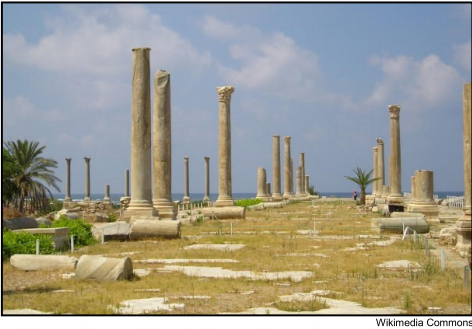 In 841 BC Shalamaneser III, king of Assyria, received tribute from Jehu, king of Israel, an event commemorated on the famous Black Obelisk. In 1951 another inscription of Shalmaneser was found that again recorded Jehu's tribute, but in addition mentioned tribute from Ba'lmanezer, king of Tyre in the same year. Scholars recognized this name as occurring in the list of Tyrian kings and their reign lengths given by Josephus in excerpts that Josephus claimed were taken from the state archives of Tyre. Josephus claimed that these archives existed in his day (about AD 100) and could be examined there. With this new credibility that was credited to Josephus's list, scholars, including Frank Moore Cross Jr., were able to construct a chronology of Tyrian kings and events in their reigns that dated Tyrian records for sending material to start the construction of Solomon's Temple in 968 BC, plus or minus one year. This was based solely on Tyrian data, not on anything taken from the Bible. The present articles traces these archaeological and scholarly developments and compares the resultant chronology with the chronology of Solomon as based on the Biblical data.
In 841 BC Shalamaneser III, king of Assyria, received tribute from Jehu, king of Israel, an event commemorated on the famous Black Obelisk. In 1951 another inscription of Shalmaneser was found that again recorded Jehu's tribute, but in addition mentioned tribute from Ba'lmanezer, king of Tyre in the same year. Scholars recognized this name as occurring in the list of Tyrian kings and their reign lengths given by Josephus in excerpts that Josephus claimed were taken from the state archives of Tyre. Josephus claimed that these archives existed in his day (about AD 100) and could be examined there. With this new credibility that was credited to Josephus's list, scholars, including Frank Moore Cross Jr., were able to construct a chronology of Tyrian kings and events in their reigns that dated Tyrian records for sending material to start the construction of Solomon's Temple in 968 BC, plus or minus one year. This was based solely on Tyrian data, not on anything taken from the Bible. The present articles traces these archaeological and scholarly developments and compares the resultant chronology with the chronology of Solomon as based on the Biblical data. |
2016:
The Remembrance of Daniel's "Darius the Mede" in Berossus and Harpocration
Bibliotheca Sacra 173 (Jul-Sept 2016). Co-author: Steven Anderson.
Download PDF
Download HTML |
| Modern commentators on the book of Daniel commonly assert that there is no reference in ancient extrabiblical literature to Daniel's Darius the Mede by the name "Darius," apart from writers such as Josephus who were dependent on Daniel. However, the ancient writers Berossus and Valerius Harpocration were independent of the book of Daniel, and yet referred to a king named "Darius" who reigned before the king who is currently called Darius I. These references should lead modern writers to reconsider the assertion that Darius the Mede was unknown in ancient extrabiblical literature.
|
2015:
Destruction of Jericho City IV Dated to ~1400 BC by Pumice from Thera,
Pottery, Scarabs, and Relative Radiocarbon Dates
Download PDF
Download HTML
|
Paper presented at annual meeting of the Near East Archaeological Society, November 18, 2015, Atlanta, GA.
Radiocarbon dating of the Theran eruption has placed the event between 1627 and 1600 BC at the 95% confidence level. The art and pottery motifs at the site of Akrotiri, buried under the tephra, were dated by archaeologists to the Late Minoan 1A, about 150 years later than this 'scientific' date, thus
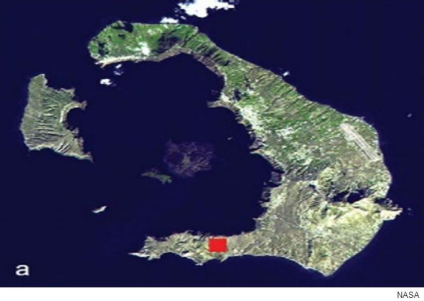 producing a conflict between archaeologists (especially Egyptologists) and those who hold the radiocarbon dates paramount. The presentation focussed on a strong evidence in favor of the archaeologists: the sudden appearance of Theran pumice at Tell el Dab'a stratum C/2, dated by Manfred Bietak to the reigns of Thutmose III and Amenhotep II (roughly 1450 to 1400 BC). Both pharaohs are represented by scarabs in this layer. The same is true of pumice found in the Levant (Tell el-'Ajjul, Ashkelon, Tel Na'ami) "only from the Late Bronze Age onwards, whilst all pumice from Middle Bronze Age strata is from other volcanoes" (Bietak 2004). Currently, no one has refuted such statements by respected Egyptologists and Levantine archaeologists. The pumice evidence thus places the Theran eruption about 1450 BC or slightly thereafter. The unadjusted BP (Before Present) radiocarbon date for the LB destruction of Jericho City IV is 45 +/- 15 years later than the BP date for Thera. By comparing BP dates instead of the controversial 'adjusted' 14C dates, the destruction level at Jericho City IV dates to the late 15th or early 14th centuries BC, in agreement with the Late Bronze pottery from the site examined by Bryant Wood and John Garstang, and in conflict with Kathleen Kenyon's much-quoted "Middle Bronze" date of 1580-1550 BC for the destruction.
producing a conflict between archaeologists (especially Egyptologists) and those who hold the radiocarbon dates paramount. The presentation focussed on a strong evidence in favor of the archaeologists: the sudden appearance of Theran pumice at Tell el Dab'a stratum C/2, dated by Manfred Bietak to the reigns of Thutmose III and Amenhotep II (roughly 1450 to 1400 BC). Both pharaohs are represented by scarabs in this layer. The same is true of pumice found in the Levant (Tell el-'Ajjul, Ashkelon, Tel Na'ami) "only from the Late Bronze Age onwards, whilst all pumice from Middle Bronze Age strata is from other volcanoes" (Bietak 2004). Currently, no one has refuted such statements by respected Egyptologists and Levantine archaeologists. The pumice evidence thus places the Theran eruption about 1450 BC or slightly thereafter. The unadjusted BP (Before Present) radiocarbon date for the LB destruction of Jericho City IV is 45 +/- 15 years later than the BP date for Thera. By comparing BP dates instead of the controversial 'adjusted' 14C dates, the destruction level at Jericho City IV dates to the late 15th or early 14th centuries BC, in agreement with the Late Bronze pottery from the site examined by Bryant Wood and John Garstang, and in conflict with Kathleen Kenyon's much-quoted "Middle Bronze" date of 1580-1550 BC for the destruction. |
| 2013c:
Radio presentation on chronology of the kingdom period |
Michael Gleghorn (PhD, Dallas Theological Seminary) is the husband of Hannah Gleghorn whose graphic arts skills are mentioned in the entry immediately below. Michael is an associate of Probe Ministries, a Christian ministry dedicated to integrating faith and learning through biblically based scholarship. As a part of their ministry, they have three-minute 'podcasts' that are heard on 600 radio stations weekly. These podcasts are archived, in audio and written text, on the probe Web site, www.probe.org.
The five podcasts for the week of April 7-11 2014 deal with the chronology of the Hebrew kingdom period. Michael writes, "I was inspired to write this program (which has been co-authored with Rodger Young) as a result of conversations with my wife, who struggled mightily with the "mysterious numbers" in Kings and Chronicles for quite some time before encountering the help provided in the book by Edwin Thiele and, more particularly, the articles of Rodger Young. Rodger and I hope that it serves to strengthen your faith in the accuracy and reliability of this important section of Scripture."
Many critics, both those educated and those uneducated in historical issues, maintain that there are errors in the Bible so that it cannot be trusted in matters of history. Some areas of biblical history can be tested for validity, some cannot. Most miracles, for example, cannot be verified from extra-biblical sources; one either accepts that what the Bible says about a miracle is true because of the presupposition that the Bible is a reliable source of information, or one denies the miracle because of a presupposition that God does not exist, or if He does exist, He is incapable or perhaps unwilling to intervene in the course of human affairs with a miracle. (The miracle of the resurrection of Christ, however, does not rely solely on a presupposition or 'blind faith,' since it is verifiable from sources outside the Bible, as many one-time atheists and agnostics such as myself have found out after investigation.)
When it comes to things like dates of events, however, there are many places where the Bible can be checked against firmly established historical dates, and can also be checked as to whether its dates are internally consistent over the more than four centuries of the kingdom period. The Probe podcasts discuss how the Bible comes out in this kind of examination.
|
|
Chart of Hebrew Kings and Prophets |
| A notable commercial artist, Hannah Gleghorn, has graciously provided a one-page chart showing, in parallel, the reigns of the kings of Israel and Judah, along with the prophets who spoke the word of God in their reigns. The chart is consistent with the modifications to Thiele's chronology of the kingdom period that are presented in the papers listed above and summarized in the "Tables of Reign Lengths" paper. Mrs. Gleghorn originally designed the chart for use in her teaching a women's Bible study group. The chart is also available as a menu choice after clicking on the "Chronological Tables" option below.
|
2013b:
Eclipses: The Science and the Pseudoscience
Bible & Spade 26:2 (Spring 2013)
Download PDF
Download HTML |
|
 This one-page addendum to the article "How Lunar and Solar Eclipses Shed Light on Biblical Events" explains why the lunar surface that is in the umbra (full shadow) of the earth nevertheless is not completely dark, and why, when viewed at sunset or sunrise, it takes on a deep red color. Eclipses, whether of the sun or the moon, are not rare. There are from two to five solar eclipses that can be viewed from somewhere on earth each year, and every year there is at least one lunar eclipse of one type or another. A cautionary note is sounded regarding recent claims that lunar and solar eclipses that NASA tables show will occur in 2014 are end-time events. A closer look at when these eclipses occur, and from where on earth they will be visible, shows that such claims are not based on a proper understanding of the astronomy involved.
This one-page addendum to the article "How Lunar and Solar Eclipses Shed Light on Biblical Events" explains why the lunar surface that is in the umbra (full shadow) of the earth nevertheless is not completely dark, and why, when viewed at sunset or sunrise, it takes on a deep red color. Eclipses, whether of the sun or the moon, are not rare. There are from two to five solar eclipses that can be viewed from somewhere on earth each year, and every year there is at least one lunar eclipse of one type or another. A cautionary note is sounded regarding recent claims that lunar and solar eclipses that NASA tables show will occur in 2014 are end-time events. A closer look at when these eclipses occur, and from where on earth they will be visible, shows that such claims are not based on a proper understanding of the astronomy involved. |
2013a:
How Lunar and Solar Eclipses Shed Light on Biblical Events
Bible & Spade 26:2 (Spring 2013)
Download PDF
Download HTML |
Astronomers and historians make use of ancient records that mention eclipses of the sun or moon to assign precise dates to various historical events. As an example, Josephus mentions an eclipse of the moon shortly before the death of Herod the Great, and this had been used in the past to date
 Herod's death to 4 BC. More recent examination of the historical material related to the death of Herod means the eclipse in question must have been the full eclipse of January 10, 1 BC, rather than the partial lunar eclipse of March 13, 4 BC. This supports the date that early Christian writers gave for the birth of Christ rather than the 4 BC date erroneously given in most modern sources.
Herod's death to 4 BC. More recent examination of the historical material related to the death of Herod means the eclipse in question must have been the full eclipse of January 10, 1 BC, rather than the partial lunar eclipse of March 13, 4 BC. This supports the date that early Christian writers gave for the birth of Christ rather than the 4 BC date erroneously given in most modern sources.
The Bur-Sagale solar eclipse of 763 BC has been related by various writers to the ministry of Jonah in Nineveh. Additional material from the Assyrian Eponym Canon is cited that may allow a more precise dating of Jonah's Nineveh ministry.
Recently, astronomical calculations from British physicists Colin Humphreys and Graem Waddington have shown that there was a lunar eclipse that became visible just after sundown, three and one-half hours after the death of Christ. Lunar eclipses occuring immediately after sundown have been observed in modern times, and the appearance of the moon at that time has been described as blood red. What this would have meant to the people of Jerusalem who had just witnessed the death of God's Messiah is discussed in detail. |
2012:
Correlation of Select Classical Sources Related to the Trojan War with Assyrian and Biblical Chronologies
JESOT 1:2 (Nov 2012)
Download PDF
Download HTML |
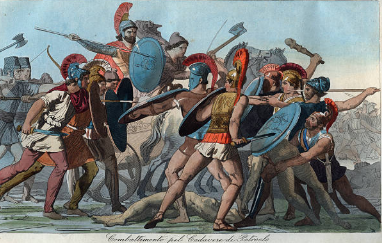 The cast of characters includes a Phoenician princess renowned for her beauty, her evil brother, a scholar who measured the size of the earth before anyone traveled around it, a turncoat general who became a historian, an unknown scribe who thought that recording when new forms of poetry were introduced was as important as when battles were fought, and that wisest of all men, who sought to match wits with the king of an island fortress.
The cast of characters includes a Phoenician princess renowned for her beauty, her evil brother, a scholar who measured the size of the earth before anyone traveled around it, a turncoat general who became a historian, an unknown scribe who thought that recording when new forms of poetry were introduced was as important as when battles were fought, and that wisest of all men, who sought to match wits with the king of an island fortress.
Comment from JESOT reviewer A: "This is a most stimulating and creative bit of scholarship that I personally find helpful in drawing attention to the vast information available in classical and early Phoenician sources." Reviewer B: "This is an extremely well-done article in fact it will become a staple in the field for years to come." |
| 2011:
Book review of Steinmann's From Abraham to Paul |
The editors of the
Associates for Biblical Research web site
asked that I write a critical review of Andrew Steinmann's
From Abraham to Paul: A Biblical Chronology.
I asked that they get someone else to do it. I would not be regarded as an objective reviewer,
because the book accepts all my corrections to Thiele's chronology of the kingdom period, and so it was a foregone conclusion that I would be favorably disposed toward at least this portion of the book. I was urged to do it anyway.
The review has two parts. Part 1
gives some background material. It describes how chronologists have,
over the centuries, tried to systematize the Bible's chronological information
and how From Abraham to Paul fits into this historical overview.
Part 2 critiques the individual chapters of the book. Hopefully, readers will
not think that once they have read the comments on the chapters,
they need not bother to read the book, which contains much more information than found in my comments. |
|
From Abraham to Paul: A Biblical Chronology,
by Andrew Steinmann |
Andrew Steinmann, Distinguished Professor of Theology and Hebrew at Concordia University Chicago, has authored this significant new book dealing with the biblical history from the time of Abraham to the NT period, ending with the deaths of Paul and Peter. All issues discussed in the papers listed above on this Web page, and much more, are dealt with in Dr. Steinmann's work. The method of presentation is well thought out. After some introductory matters, including the measurement of time in the ancient world and the importance of a proper chronology in understanding the working of God in history, certain benchmarks are determined from which the basic chronology of the OT can be filled in. These basic dates are the chronology of Solomon's reign, and from there the date of the Exodus, the date of Jacob's descent into Egypt, and the date of Abraham's birth.
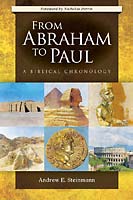 A thorough discussion is given on how these basic dates are established. Archaeological issues, including radiocarbon dating, are addressed in the process. Having established these benchmarks, Dr. Steinmann then goes on to fill in the biblical chronology, starting with Abraham and concluding with the time of the New Testament. Much of this material has not appeared before in book form because of the considerable advance in understanding of some of these issues that has transpired from scholarly studies in the last ten or fifteen years.
A thorough discussion is given on how these basic dates are established. Archaeological issues, including radiocarbon dating, are addressed in the process. Having established these benchmarks, Dr. Steinmann then goes on to fill in the biblical chronology, starting with Abraham and concluding with the time of the New Testament. Much of this material has not appeared before in book form because of the considerable advance in understanding of some of these issues that has transpired from scholarly studies in the last ten or fifteen years.
Most of this understanding has come from scholars with a high view of the inspiration of Scripture, or at least from those who followed the inductive method of starting with the biblical texts and giving the ancient authors the benefit of the doubt, rather than with speculations that assume a priori that the historical parts of the OT were written, or redacted, at a time much later than the events described.
I am not alone in believing that this book is a highly significant achievement. As quoted in the endorsements, Eugene Merrill wrote, "Steinmann lays out here a foundation that doubtless will provide the basis for all subsequent discussions of biblical chronology." An advertisement for the book is available at Amazon. For an advertisement with more information, including a view of some of the contents, see the Concordia Publishing House
advertisement by clicking on the front-cover image to the right. |
Josephus Misdated the Census of Quirinius, by John Rhoads,
JETS 54:1 (March 2011)
Download PDF
Download HTML
|
|
John Rhoads has made an impressive debut into the field of Biblical chronology with this essay in the March 2011 issue of JETS. At the time of writing, John was assistant professor of theology at Concordia University Chicago. It is a commonplace among various scholars that Luke's statement that a Roman census brought Mary and Joseph to Bethlehem (Luke 2:1-7) is an anachronism and mistake, because the Quirinius mentioned in Luke 2:2 did not come to Syria and Judea until AD 6, according to Josephus in his Antiquities (18:2:1/26-28). However, other passages in Josephus are consistent with Quirinius coming to Syria and Judea before the death of Herod the Great (died early 1 BC--see A. Steinmann,
"When Did Herod the Great Reign", Novus Testamentum 50 [2009], pp. 1-29). For a synopsis of part off Rhoads' demonstration that Qurinius came to Syria before Herod died, and so the taxation associated with his name must have taken place before 1 BC, click here. |
Translation of Coucke's 1928 article on OT chronology
Download PDF Download HTML |
Much of Coucke's research has been
 superseded by later studies, but, as mentioned below, he provided some insights that have not been fully appreciated by subsequent investigators. One such insight is his determination of the year in which construction began on Solomon's Temple based on records taken from the archives of Tyre (the Tyrian King List, as found in Josephus, Menander, and Dius). From these classical (non-biblical) sources, Liver, Barnes, and Cross all derived the same date, 968/67, that Coucke derived for this event, although they were unaware of Coucke's earlier work. But another innovative area of Coucke's research has not heretofore been pursued by later scholars. This is his deriving the same date by another method, one that starts with the date for the Fall of Troy given in the Parian Marble, and also in some texts of the Canons of Eusebius. This method is likewise independent of the biblical data. It is also independent of the Tyrian King List. In the hope that others besides just Andrew Steinmann and myself will investigate this line of reasoning and its significance for the history of the Trojan War and for early Greek chronology, I have translated Coucke's 1928 article and made the translation available in the link above.
superseded by later studies, but, as mentioned below, he provided some insights that have not been fully appreciated by subsequent investigators. One such insight is his determination of the year in which construction began on Solomon's Temple based on records taken from the archives of Tyre (the Tyrian King List, as found in Josephus, Menander, and Dius). From these classical (non-biblical) sources, Liver, Barnes, and Cross all derived the same date, 968/67, that Coucke derived for this event, although they were unaware of Coucke's earlier work. But another innovative area of Coucke's research has not heretofore been pursued by later scholars. This is his deriving the same date by another method, one that starts with the date for the Fall of Troy given in the Parian Marble, and also in some texts of the Canons of Eusebius. This method is likewise independent of the biblical data. It is also independent of the Tyrian King List. In the hope that others besides just Andrew Steinmann and myself will investigate this line of reasoning and its significance for the history of the Trojan War and for early Greek chronology, I have translated Coucke's 1928 article and made the translation available in the link above.
March 8, 2018: I have updated my translation, correcting errors and expanding my comments, especially on Coucke's Maccabeean chronology. In his analysis of 1 Maccabees, Coucke came to the erroneous conclusion that the author of 1 Maccabees accepted the first year of the Seleucid Era as the year beginning on Nisan 1, 312 BC, instead of the 1 Nisan 311 BC accepted by more recent scholars, and which is more in harmony with most of the texts cited.
|
2010:
The Parian Marble and Other Surprises from Chronologist V. Coucke,
AUSS 48:2 (Fall 2010)
Download PDF
Download HTML |
In a footnote in Mysterious Numbers, Edwin Thiele acknowledged that some of his most basic principles were discovered, unknown to him, by classical scholar Valerius Coucke, a professor at
Het Grootseminarie Brugge (Le Grand Séminaire de Bruges) in Belgium in the 1920s. From the bibical data as correlated with known chronological practices in the ancient Near East, Coucke had independently derived the following basic principles of Thiele's system: (1) That Judah used a Tishri-based regnal year, whereas Israel used a Nisan-based regnal year; (2) Initially, Judah used accession reckoning for its kings, while Israel used nonaccession reckoning; (3) In the 9th century BC, during the rapprochement between the two kingdoms, Judah adopted Israel's nonaccession reckoning;
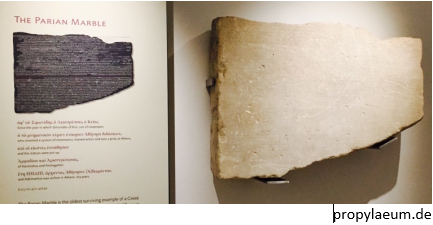 (4) Both kingdoms eventually went to accession reckoning, and (5) The chronology of the kingdom period cannot be understood successfully unless it is acknowledged that coregencies were a known, and utilized, principle during this time.
(4) Both kingdoms eventually went to accession reckoning, and (5) The chronology of the kingdom period cannot be understood successfully unless it is acknowledged that coregencies were a known, and utilized, principle during this time.
It has long been recognized that Coucke's independent discovery of these principles that are at the core of Thiele's system serves as a strong support for the essential soundness of the principles, although there remained details in the work of both scholars that needed
modification (see my articles below for some of them). Coucke's work, when presented to Thiele by Siegfried Horn some two years after Thiele's initial 1944 publication, was certainly a pleasant surprise to both Thiele and Horn. This is the first of five surprises that are described in the present paper. The other surprises: (2) Coucke's use of an exact notation to express Tishri Years and Nisan years, similar in its details to the notation that I introduced in my "Solomon" paper, and also similar to the notation that Daiqing Yuan had used in his 2006 ThM thesis at DTS; (3) Coucke's use of the Parian Marble's date for the fall of Troy and other classical sources to determine, completely independently of any biblical reference or biblical date, that construction began on Solomon's Temple in either 969/68 or 968/67 BC; (4) Coucke's further use of classical sources--this time the Tyrian King List of Menander plus Pompeius Trogus--to do another calculation that put the beginning of Temple construction as either 968/67 or 967/66 BC (the scholars I mention in my "Three Verifications" paper used the Tyrian King list in the same way to derive 968/67 BC for the beginning of construction of the Temple, although neither they nor I had read Coucke's work); Coucke then used these two dates in conjunction with the two dates of (3) to limit the start of Temple construction to 968/67, one year earlier than the date derived from Thiele's chronology for Solomon but in agreement with the date derived from the biblical and Assyrian data in my "Solomon" paper, and (5) His use of Ptolemy's Canon and 2 Kgs 25:27 to correctly date the fall of Jerusalem to 587 BC.
One authority in this field, when presented with Coucke's two independent methods of deriving the date for start of construction of Solomon's Temple from classical authors, responded that since Josephus cited Menander, and Josephus also used the Bible in his writing, everything was ultimately derived from the Bible and so anything in the writing of Josephus or Menander that seemed to verify the Bible was circular reasoning. This in spite of the fact that nothing in the sources cited by Coucke in items (3) and (4) just above is based on a biblical text. It does show, however, that there is a certain antipathy in parts of the scholarly world against any writer who might be suspected of trying to demonstrate the accuracy of the Bible's historical data. With this in mind, the present paper states that Coucke's approach does not "prove" that the biblical chronology that gives the date of Temple construction is true, but just the opposite: the date of Temple construction, which can be determined securely and precisely by other means
(see "Three Verifications"), gives credibility to the Parian Marble's date for the Fall of Troy. The Parian Marble's date for that event (June 10, 1208 BC) is 25 years earlier than the commonly accepted date of 1183 BC, which leads to to an interesting study on the sources and reasons for the 1183 date. This is a complex question that requires looking at the classical sources for dating the Fall of Troy, but such research requires more space and attention that could be given in the present paper. For that reason, Andrew Steinmann and I subsequently wrote the paper "Correlation of Select Classical Sources . . ." that addresses such issues as why there are two traditions in Eusebius' Canons regarding the dates of Troy, one of which agrees with the Parian Marble's 1208 date and the other which agrees with Eratosthenes' 1183 date. Dr. Steinmann is the one who found a copy of Coucke's original publication in the Wheaton College library, and so started this present investigation into the writings of Coucke.
|
| 2008d:
Acceptance of my revised chronology of Solomon thru Athaliah in recent research |
In August 2008, Leslie McFall added to his website a revised table of the chronology of the kings of Judah, with the caption,
The suggestion that Solomon died between Nisan (April) and Elul (August) 931 B.C. was first put forward by Rodger Young, "When Did Solomon Die?" JETS 46 (2003) 589-603.
Consequently, the first four Judean kings (from Rehoboam to Jehoshaphat) have been
moved back one year. The implication of this minor, but very important, shift does away
with Thiele's suggestion that Judah's system was imposed on Israel's for these four kings
by the biblical scribes.
One slight correction to this: Solomon could have died any time in the year preceding Tishri of 931 BC, rather than his death happening in just the latter six months of that year, as explained in ''Table of Reign Lengths,'' footnote 3. Dr. McFall's note has now been verified in his latest publications. In an article in JETS 52:4 (December 2009), p. 690, note 43, he graciously writes, "I am indebted to Rodger Young for this precise dating of the Division; see his essay "When Did Solomon Die?" JETS 56 (2003) 599-603." In a subsequent publication (McFall, "The Chronology of Saul and David," JETS 53 [2010]: 533 [chart]), Dr. McFall shows that he also accepts the modifications that this implies for the reigns of Rehoboam through Athaliah. Other recent publications that include this one-year correction to Thiele's chronology include Bryant G. Wood, "The Rise and Fall of the 13th-Century Exodus-Conquest Theory," JETS 48 (2005): 477, 488; Douglas Petrovich, "Amenhotep II and the Historicity of the Exodus Pharaoh," MSJ 17 (2006): 83; Andrew E. Steinmann, From Abraham to Paul: A Biblical Chronology (St. Louis: Concordia, 2011), 133-34, 138.
This small one-year correction in the timing of events from which we are three thousand years distant might seem like unnecessary hair-splitting over matters of no real consequence to the modern world, or even to our understanding of the history of the time. Getting the chronology of this time correct is important, however, for a least three reasons:
1) Egyptologists use the chronological note of 2 Chr 12:2 in conjunction with an inscription of Sheshonq I of Egypt's 22nd Dynasty to given an absolute (B.C.) date to Shoshenq's inscription, based on Thiele's date of spring 965 B.C. for Shoshenq/Shishak's invasion. From this anchor point, Egyptologists then determine absolute dates for all of Egypt's 21st and 22nd Dynasties, dates that could only be reckoned approximately based on Egyptian inscriptions alone. Egyptologists thereby demonstrate more confidence in this historical section of the Bible than do many Biblical commentators.
2) With the one-year correction to Thiele's dates, the rhythm of the Jubilee and Sabbatical cycles is established correctly. Thiele's chronology for 1 Kgs 6:1 would place the Exodus and the start of the Conquest one year too late; with the proper dates of 1446 and 1406 B.C. for these events, all Biblical events related to the Jubilee and Sabbatical years, from the start of counting of these cycles in 1406 B.C. until the time for the 17th Jubilee to begin on Tishri 10 of 574 B.C. (Ezek 40:1), fall into place. This has important implications not only for showing that the counting for these cycles started in 1406 B.C., thus establishing a 15th-century Exodus, but also for showing that the Book of Leviticus that chartered the Jubilee and Sabbatical cycles was in existence at that time.
3) Showing that the Bible—here specifically, the OT—is accurate in minute historical details has apologetic value. This should not be in conflict with using the best historical methodology. The best methodology has instead supported a high view of the inspiration of Scripture. Those who follow the presupposition-based approach of the surviving debris of the Documentary Hypothesis use poor historical methodology to promote their agenda. Correspondingly, Christian historians should not be ashamed to use their abilities to promote faith in the Word of God. This is what our Lord and the Apostle Paul did when they argued that specific events in space and time show that the Biblical texts related to these events were accurate and inspired (Matt 12:39,40; Acts 9:22, 17:2,3). For those of us historians who claim to be Christian, let our model and our "agenda" be those of the Lord and His apostles. On the Great Day, the approval of the scholarly community will count for nothing. Approval of the Lord of heaven and earth will count for everything.
|
2008c:
Evidence for Inerrancy from a Second Unexpected Source: the Jubilee and Sabbatical Cycles
Bible & Spade 21:4 (Fall 2008)
Download PDF
Download HTML |
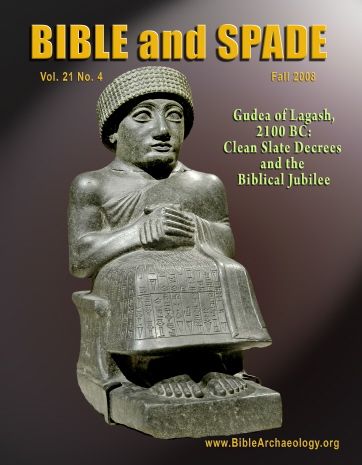 s
The Jubilee implied by the Hebrew text of Ezek 40:1 allows a calendar of Jubilee and Sabbatical years to be constructed. This calendar is exactly consistent with the date of 1406 BC for the entry into Canaan that is derived from 1 Kings 6:1 and Thiele's date for the division of the kingdom. This two-fold precision establishes the historical accuracy (i.e. inerrancy) of all the Scriptural texts that Thiele used to derive the time of the division. It also establishes that the book of Leviticus that instigated the observance of the Jubilee and Sabbatical cycles must have been in existence in 1406 BC. Until unbelieving scholarship can give a better explanation of these facts, the only intellectually honest conclusion is that Leviticus is a revelation from God to His servant Moses--a precept repeatedly and emphatically stated in the book itself. s
The Jubilee implied by the Hebrew text of Ezek 40:1 allows a calendar of Jubilee and Sabbatical years to be constructed. This calendar is exactly consistent with the date of 1406 BC for the entry into Canaan that is derived from 1 Kings 6:1 and Thiele's date for the division of the kingdom. This two-fold precision establishes the historical accuracy (i.e. inerrancy) of all the Scriptural texts that Thiele used to derive the time of the division. It also establishes that the book of Leviticus that instigated the observance of the Jubilee and Sabbatical cycles must have been in existence in 1406 BC. Until unbelieving scholarship can give a better explanation of these facts, the only intellectually honest conclusion is that Leviticus is a revelation from God to His servant Moses--a precept repeatedly and emphatically stated in the book itself.
To access a text-only version that is somewhat more readable than the version with graphics, click here. |
2008b:
Evidence for Inerrancy from an Unexpected Source: OT Chronology
Bible & Spade 21:2 (Spring 2008)
Download PDF
Download HTML |
Dr. Wood asked to reprint in Bible and Spade my talk at the Nov. 2005
annual meeting of the Evangelical Theological Society. This has already been reprinted once, modified
 somewhat at the end, in TMSJ (the "Inductive and Deductive" article). With permission of the editors of TMSJ, it appears in Bible and Spade with a different ending. Instead of discussing Menahem's tribute, the new ending emphasizes the theological significance of the accuracy of the chronological details of the OT.
somewhat at the end, in TMSJ (the "Inductive and Deductive" article). With permission of the editors of TMSJ, it appears in Bible and Spade with a different ending. Instead of discussing Menahem's tribute, the new ending emphasizes the theological significance of the accuracy of the chronological details of the OT.
To access a text-only version that is somewhat more readable than the version with graphics, click here.
|
2008a:
A Critical Analysis of the Evidence from Ralph Hawkins for a Late-Date Exodus-Conquest
JETS 51:2 (June 2008)
Download PDF Download HTML |
|
(With Bryant Wood, archaeologist) The Israeli archaeologist Adam Zertal has published various articles regarding excavations at a site on Mt. Ebal. Zertal identifies a large structure at this site, dated to 1200 BC or slightly later, as the altar described in Josh. 8:30-31. If this identification were true, it would place the entry into Canaan about 1200 BC and the Exodus in 1240 BC. In the March 2007 issue of JETS, Ralph Hawkins advocated Zertal's identification. 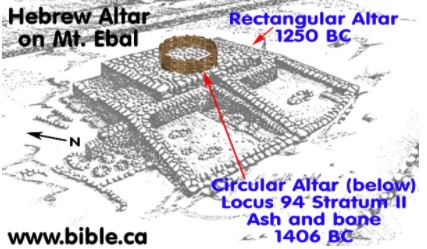 Since a date this late cannot be reconciled with the 480 years of 1 Kgs 6:1 or the chronology of Judges, Hawkins denigrates the treliability of the chronological data of the books of Kings and Judges. In our response, Bryant shows that the object that Zertal identifies as Joshua's altar is of the wrong size and shape and in the wrong time period to be identified with Joshua. My part of the article summarizes several of my articles listed above and explains why these research papers, in conjunction with other scholarly works, now provide a formidable argument for the historical exactness of the chronological data of the Scriptures, contra Hawkins and the authorities he cites. Since a date this late cannot be reconciled with the 480 years of 1 Kgs 6:1 or the chronology of Judges, Hawkins denigrates the treliability of the chronological data of the books of Kings and Judges. In our response, Bryant shows that the object that Zertal identifies as Joshua's altar is of the wrong size and shape and in the wrong time period to be identified with Joshua. My part of the article summarizes several of my articles listed above and explains why these research papers, in conjunction with other scholarly works, now provide a formidable argument for the historical exactness of the chronological data of the Scriptures, contra Hawkins and the authorities he cites.
Note added, June 2020: Bryant and I now agree that we were too hasty in saying that "Zertal's altar" is in the wrong place to be Joshua's altar. The Biblical text does not require that the altar had to be located exactly where the recitation of the Law took place. Some new evidence shows that 1) Zertal's altar may indeed be in the place that Joshua placed his altar, and 2) The new evidence reinforces our argument that Joshua's altar was not built in the 13th century BC (so Zertal and Hawkins), but in the 15th century BC. This new development comes because it was found that Zertal's altar, which we agree should be assigned to the 13th century BC, is built over, and centered exactly on, a smaller and earlier round altar. The 13th-century Israelites would not have honored an earlier pagan altar in this way. The present political situation does not allow excavations that could possibly validate more exactly the date of the earlier altar, but there is some hope that such will be allowed in the future. For further information on this important topic, see the report by Dr. Scott Stripling in the video, "
Has Joshua's Altar Been Found on Mt. Ebal?."
Note added, June 2024: Abigail Leavitt's book,
The El-Burnat (A) Structure(s): Joshua's Altar?, pp. 44-46, lists four pottery artifacts associated with the earlier altar that shows this altar was built before 1300 BC but after 1500 BC. Zertal found this pottery, plus ashes and bones, all associated with the earlier altar, and Zertal recognized from these artifacts that the earlier altar was Israelite, not Canaanite. The larger, 13th century altar was built over the smaller altar and centered on it, as if to honor and protect it. The pottery associated with the earlier altar is consistent with Israel's entry into Canaan in 1406 BC but not consistent with a 13th century Exodus. Leavitt is an expert in Bronze Age pottery, and is currently (2024) the assistant director of the archaeological excavations at Shiloh.
It is quite unusual to find plaster associated with an altar in the Levant. But see Deut 27:4-6 and Joshua 8:30-32: At the command of Moses, Joshua covered the altar with plaster and wrote on it a copy of the law of Moses. A box of the plaster is currently at the University of Haifa, where Zertal took it in the 1980s.
|
| 2007c:
Review of Tetley, "Reconstructed Chronology of the Divided Kingdom" AUSS 45:2 (Fall 2007) |
Thiele's method of determining the chronology of the divided kingdom has been
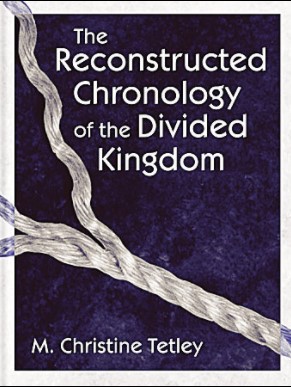 characterized as "too complicated." The problem was not with Thiele; the problem is that we must first
understand the methods used by ancient scribes, both Hebrew and non-Hebrew, in recording chronological information. When did their year begin? Did they use accession or nonaccession reckoning? And so on. In order to reduce the complexity that such an approach involves, Christine Tetley attempted to make simplifying assumptions and thereby produce a "reconstructed chronology." Her book is also an extensive attempt to give credence to LXX variations of chronological data in Kings and Chronicles. My review evaluates whether these approaches have met with any success. characterized as "too complicated." The problem was not with Thiele; the problem is that we must first
understand the methods used by ancient scribes, both Hebrew and non-Hebrew, in recording chronological information. When did their year begin? Did they use accession or nonaccession reckoning? And so on. In order to reduce the complexity that such an approach involves, Christine Tetley attempted to make simplifying assumptions and thereby produce a "reconstructed chronology." Her book is also an extensive attempt to give credence to LXX variations of chronological data in Kings and Chronicles. My review evaluates whether these approaches have met with any success. |
2007b:
Three Verifications of Thiele's Date for the Beginning of the Divided Kingdom
AUSS 45:2 (Fall 2007)
Download PDF
Download HTML |
 By a careful study of the chronological methods of the Scriptural authors, Edwin Thiele established that the divided monarchy began in the year that started in Nisan (roughly April) of 931 BC. My "Solomon" paper refined this to say that Solomon died before Tishri (roughly October) of that year. His last official year of reign therefore began in Tishri of 932. The Jubilee data, in conjunction with 1 Kings 6:1, establish this date, independently of the work of Thiele. Compleletely independent of either of these two methods, the list of Tyrian kings found in Josephus (and tied to Roman data for the founding of Rome) gives the date of 932 BC for the death of Solomon, plus or minus two years at the most, according to the work of J. Liver, Frank Cross, and Wm. Barnes. This paper compares these three methods of arriving at this crucial date and shows that the three methods are fundamentally independent. The consequences are not only that the date is firm, but that the complex and profuse chronological data of the Scriptural history are entirely trustworthy. This is a finding that was unanticipated by liberal scholarship, with its low view of the inspiration of Scripture and its faulty historical methods.
By a careful study of the chronological methods of the Scriptural authors, Edwin Thiele established that the divided monarchy began in the year that started in Nisan (roughly April) of 931 BC. My "Solomon" paper refined this to say that Solomon died before Tishri (roughly October) of that year. His last official year of reign therefore began in Tishri of 932. The Jubilee data, in conjunction with 1 Kings 6:1, establish this date, independently of the work of Thiele. Compleletely independent of either of these two methods, the list of Tyrian kings found in Josephus (and tied to Roman data for the founding of Rome) gives the date of 932 BC for the death of Solomon, plus or minus two years at the most, according to the work of J. Liver, Frank Cross, and Wm. Barnes. This paper compares these three methods of arriving at this crucial date and shows that the three methods are fundamentally independent. The consequences are not only that the date is firm, but that the complex and profuse chronological data of the Scriptural history are entirely trustworthy. This is a finding that was unanticipated by liberal scholarship, with its low view of the inspiration of Scripture and its faulty historical methods. |
2007a:
Inductive and Deductive Methods As Applied to OT Chronology
TMSJ 18:1 (Spring 2007)
Download PDF
Download HTML |
|
This is an overview of the developments of conservative scholars in the field of OT chronology. The approach and successes of these scholars is contrasted with the methods and lack of consensus among scholars with a low view of the inspiration of Scripture. The article ends with a discussion of why the date that Hayim Tadmor gives for the tribute of Menahem of Israel to Tiglath-Pileser III cannot be the correct date. Tadmor's date is used by many scholars as a reason for not accepting the integrity of the biblical chronological data for the time, yet Tadmor's reasoning requires a distortion in the translation of the relevant Assyrian texts.
|
2006d:
Ezekiel 40:1 As a Corrective for Seven Wrong Ideas in Biblical Interpretation
AUSS 44:2 (Fall 2006)
Download PDF
Download HTML |
|
The ideas I put forth in my previous papers can sometimes be used to analyze very specific problems or specific Biblical texts that are difficult to interpret. These ideas are 1) The use of an exact notation for dates that matches the calendar methods in use in ancient Israel and surrounding nations, 2) The use of Decision Tables to determine which of several possible interpretations best explains the text being studied. This article applies these techniques to an in-depth analysis of Ezekiel 40:1. By properly understanding the Hebrew in this verse and exploring its implications for chronology, several conclusions can be drawn, extending even so far as establishing the date of the composition of the Pentateuch.
|
2006b & c:
Seder Olam and the Sabbaticals Associated with the Two Destructions of
Jerusalem
Jewish Bible Quarterly: First Part 34:3, Jul-Sep 2006; Second Part 34:4, Oct-Dec 2006
Download PDF of first part
Download HTML of first part
Download PDF of second part
Download HTML of second part |
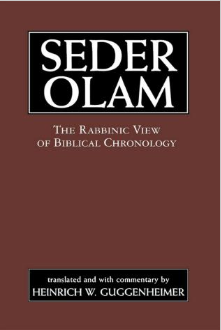 These articles are an extension of my work on Jubilee and Sabbatical cycles that showed that a complete calendar of such cycles for the pre-exilic period can be constructed. However, to avoid controversy and to keep the papers fairly short, I do not mention the Jubilee cycles here--only the Sabbatical cycles. These papers look into ancient Jewish records that declare that the destructions of both temples (the First Temple by Nebuchadnezzar in 587 BC and the Second Temple by Titus in AD 70) happened in a Sabbatical year. The original Hebrew of these sources is examined, and conclusions are drawn from this rather than from various erroneous translations of these texts into English. Scriptural texts that reinforce the conclusion that Jerusalem fell to Nebuchadnezzar in a Sabbatical year are also given.
These articles are an extension of my work on Jubilee and Sabbatical cycles that showed that a complete calendar of such cycles for the pre-exilic period can be constructed. However, to avoid controversy and to keep the papers fairly short, I do not mention the Jubilee cycles here--only the Sabbatical cycles. These papers look into ancient Jewish records that declare that the destructions of both temples (the First Temple by Nebuchadnezzar in 587 BC and the Second Temple by Titus in AD 70) happened in a Sabbatical year. The original Hebrew of these sources is examined, and conclusions are drawn from this rather than from various erroneous translations of these texts into English. Scriptural texts that reinforce the conclusion that Jerusalem fell to Nebuchadnezzar in a Sabbatical year are also given.
Note added June 2020: For a fuller treatment showing how various texts of the Seder 'Olam unambiguously assign the destruction of the First Temple to the latter part of a Sabbatical year, see Young and Steinmann,"
Caligula's Statue . . .," pages 769-772.
|
2006a:
The Talmud's Two Jubilees and Their Relevance to the Date of the Exodus
WTJ 68 (Spring 2006)
Download PDF
Download HTML |
 This expands on the idea presented in the Solomon paper regarding the Jubilees. It shows that the remembrance of the Jubilees in the Talmuds, the Seder Olam, and in the Hebrew text of Ezek 40:1 allows a complete calendar of pre-exilic Sabbatical and Jubilee years to be constructed. This calendar shows that Israel's entry into Canaan, when counting started for these cycles, must have occurred in Nisan of 1406 BC, with the Exodus therefore in 1446 BC. This calculation of the date of the Exodus is independent of the method of calculating the date based on 1 Kgs 6:1, although both give the same date. Therefore counting must really have started at that time. The conclusion is drawn that the Book of Leviticus was in existence in 1406 BC, since no reasonable alternate source for the laws of the Jubilee and Sabbatical cycles has ever been postulated, and nations of the ancient Near East are known to have put ritual and cultic matters like this in writing.
This expands on the idea presented in the Solomon paper regarding the Jubilees. It shows that the remembrance of the Jubilees in the Talmuds, the Seder Olam, and in the Hebrew text of Ezek 40:1 allows a complete calendar of pre-exilic Sabbatical and Jubilee years to be constructed. This calendar shows that Israel's entry into Canaan, when counting started for these cycles, must have occurred in Nisan of 1406 BC, with the Exodus therefore in 1446 BC. This calculation of the date of the Exodus is independent of the method of calculating the date based on 1 Kgs 6:1, although both give the same date. Therefore counting must really have started at that time. The conclusion is drawn that the Book of Leviticus was in existence in 1406 BC, since no reasonable alternate source for the laws of the Jubilee and Sabbatical cycles has ever been postulated, and nations of the ancient Near East are known to have put ritual and cultic matters like this in writing.
|
2005:
Tables of Reign Lengths from the Hebrew Court Recorders
JETS 48:2 (June 2005)
Download PDF
Download HTML |
|
This is sort of my magnum opus. It avoids the tedium that was necessary to establish the chronology of the kingdom period, since that was dealt with in the previous three papers. It focuses instead on the theological significance of this work on chronology done by myself and by those whose scholarship I followed and built on. The four tables at the end are meant to demonstrate the accuracy and believability of all Scriptural texts dealing with the chronology of the kingdom period.
|
2004b:
When Was Samaria Captured? The Need for Precision in Biblical Chronologies
JETS 47:4 (Dec. 2004)
Download PDF
Download HTML |
| This paper gives the chronology of the eighth century BC. It sorts out the mess that Thiele made when he rejected the Hoshea/Hezekiah synchronisms of 2 Kgs 18. The results are similar to those obtained by other conservative scholars, as is emphasized in this paper. The new contributions of this paper are its formalizing the notation used for dates that was presented in my two earlier papers, and its discussion of the reasons why precision is important in chronological studies.
|
2004a: When Did Jerusalem Fall?
JETS 47:1 (March 2004)
Download PDF
Download HTML |
|
The method of Decision Tables was used in the Solomon paper to sort through all the confusing possibilities and to show which ones are valid and which produce contradictions with the texts involved. In this paper, the method is applied to all Scriptures in Jeremiah, Ezekiel, 2 Kings, and 2 Chronicles relating to the date of Jerusalem's fall to Nebuchadnezzar. It is shown that all texts involved are in harmony with themselves and with each other, and the only year possible for Jerusalem's fall is 587 BC.
|
2003: When Did Solomon Die?
JETS 46:4 (Dec. 2003)
Download PDF
Download HTML |
| Edwin Thiele's date of 931 BC for the beginning of the divided monarchies has stood the test of time since it was first published in 1944. This paper examines the possibility that Solomon died before Tishri of that year, instead of on or after Tishri 1 as Thiele assumed without explaining why. This six-month correction fixes errors in Thiele's chronology of Judean kings, and also makes the date of the Exodus calculated from 1 Kgs 6:1 to be in exact agreement with the date of the Exodus as calculated from the Jubilee cycles.
|
